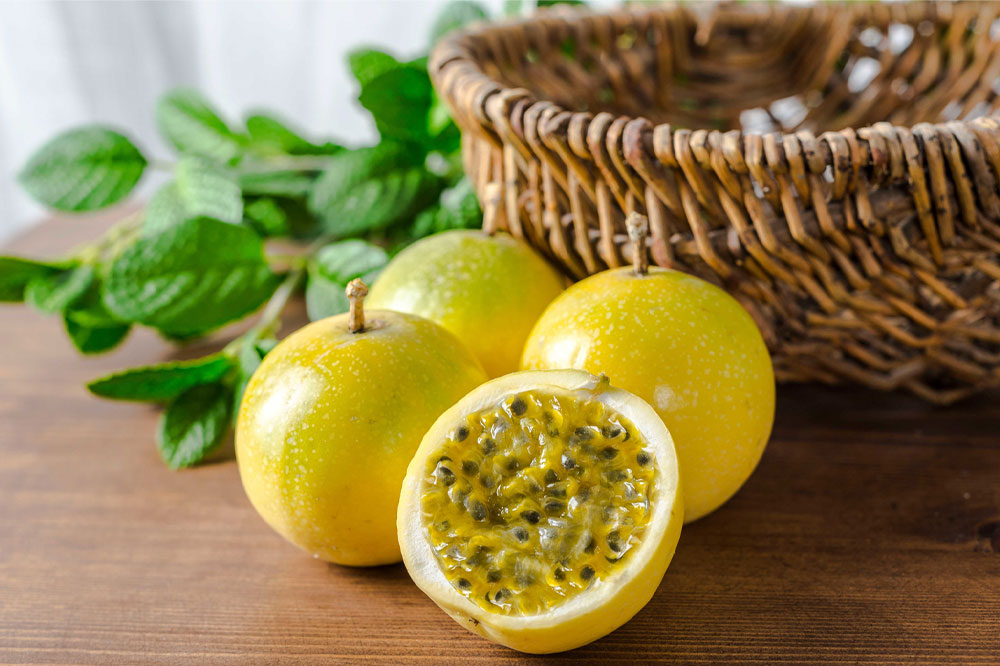
Passion fruit – Nutrition, benefits, and recipes
Passion fruit is a flowering tropical vine. It grows in warm regions like South Africa, Australia, India, and South America. Passiflora edulis is a renowned passion fruit species, but you can find several other species too. Passion fruit has a lot of seeds and a soft pulp inside the hard rind. You can eat the pulp and the seeds, juice them, or add them to other juices.
Passion fruit has garnered attention lately, as it is rich in nutrition and has several health benefits. This article sheds light on passion fruit’s nutritional profile, preparation, and uses.
Nutrition profile
Passion fruit is incredibly nutritious. It is a good source of nutrients like provitamin A, Vitamin C, and fiber. One purple passion fruit contains 17 calories, two percent of the daily recommended value of potassium, eight percent of the daily value of vitamin A, nine percent of the daily value of vitamin C, two percent of the daily value of iron, and two grams of fiber.
Note that these are the values for small, single fruit with 17 calories. Hence, it is an excellent source of Vitamin A, C, and fiber, if you compare its nutrition with other foods with a similar calorie count. Further, passion fruit is also a good source of healthy plant compounds, polyphenols, and carotenoids. Studies suggest that it has relatively more polyphenols than other tropical fruits. Moreover, it also offers a small portion of iron. Your body does not absorb the iron from plants well, but the iron in passion fruit is rich in vitamin C, which helps with iron absorption.
Benefits
- Is excellent for those who are pregnant
Those who are pregnant must definitely consider adding passion fruit to their pregnancy meal plan. It has fiber, antioxidants, minerals, and other vital nutrients. Passion fruit is also considered one of the healthiest fruits for fetal growth. Vitamin C in passion fruit can help prevent constipation and boost immunity. The calories in it keep you energized for a long. - Boosts immunity
It is an excellent source of antioxidants, beta-cryptoxanthin, alpha-carotene, and vitamin C that can improve immunity. The antioxidants present in passion fruit prevent cell damage, neutralize free radicals, and lowers oxidative stress. In addition, vitamin C amplifies the activity of the rest of the immune cells and white blood cells and makes the body resistant to infections, flu, and colds. - Is a good fiber source
Its pulp is an excellent dietary fiber source. Fiber helps keep the gut healthy and regulates the digestive system. Further, it also has cardiovascular benefits. Passion fruit’s soluble fiber cleanses waste materials and toxins from the colon and reduces the risk of colon cancer. - Is low in GI value
Passion fruit’s glycemic index value is 30. So, the sugar in this fruit is absorbed slowly into the bloodstream. Thus, there is no sharp surge in blood sugar levels upon eating it. Hence, it is an excellent choice for maintaining insulin levels in people with diabetes. It reduces sugar cravings and elevates mood. - Maintains blood pressure
Passion fruit contains alkaloids that help keep blood pressure low. It also offers antispasmodic and sedative benefits. With its low sodium and high potassium content, passion fruit improves blood flow and relaxes the blood vessels. - Improves heart health
Potassium, vitamins B6 and C, and fiber are heart-protective, and passion fruit has these nutrients in plenty. It also has almost no cholesterol and is a low-fat fruit. Fiber in passion fruit elevates HDL cholesterol and reduces LDL. Hence, it safeguards your heart. In addition, the antioxidants lower and clean the fat deposits in the inner lining of the arteries. - Lowers susceptibility to cognitive decline
Nutrients like folate, potassium, and antioxidants in passion fruit have several neurological benefits. Folate lowers the risk of cognitive decline and Alzheimer’s disease. Potassium promotes blood flow to the brain and boosts cognition, neural activity, and concentration. Further, passion fruit also has vitamin B6, the deficiency of which can lead to nausea and depression.
Preparation and recipes
For eating passion fruit, you can cut it in half, scoop out its edible seeds, and pulp it with a spoon. If you don’t want to eat whole fruit, you can make juice. The passion fruit juice recipe is very straightforward. You can press the seeds using a fine strainer and get the juice out. Its seeds are soft and large. Hence, the process does not need a lot of work. You can also convert this juice into syrup. This, again, is very straightforward. You can sieve or press the seeds through a cheesecloth, and the syrup is ready.
Adding passion fruit to salads is an excellent way to make a meal out of it. You can add grains and yogurt to the mix for a delicious punch. People also prefer using passion fruit seeds as a decorative addition to frozen treats and beverages. Mexicans prepare passion fruit with chili pepper and lime, while Australians use it with sugar and cream.




